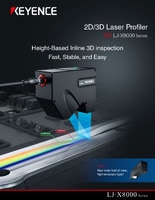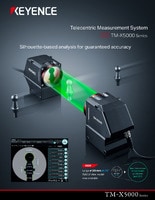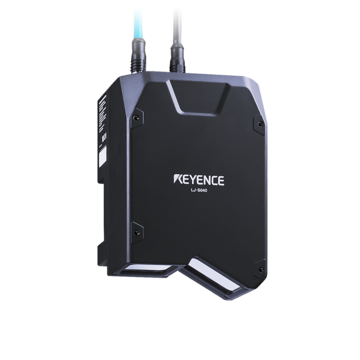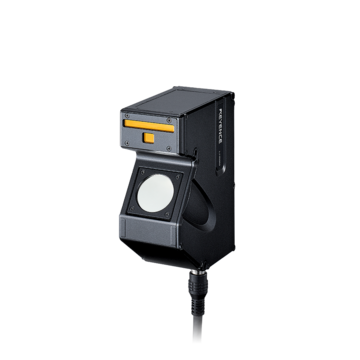Measurement Sensors
Dimension Measurement
Displacement Measurement
Cylinder Inspection and Defect Detection
In automotive manufacturing, precision parts define engine performance. Every component, down to the cylinder, must meet strict quality standards to maintain optimal engine function; even the smallest imperfection in a cylinder’s surface can compromise efficiency and reduce longevity. Advanced automotive cylinder inspection methods help manufacturers detect these issues before they escalate, which helps prevent defects from reaching final assembly.
We’re here to provide you with more details.
Reach out today!

The Importance of Cylinder Inspection in Automotive Manufacturing
An engine’s cylinders serve as the heart of internal combustion engines, housing the pistons, controlling combustion, and keeping the engine running. Any variation in their dimensions, surface integrity, or material composition can affect compression and fuel efficiency. Even minor defects in a cylinder can cause long-term problems. Inspection tools work to catch these flaws before they compromise structural integrity- keeping engines running under any condition.
Traditional inspection methods relied on manual visual checks, but inconsistencies in human evaluation made precision difficult to maintain. To prevent inconsistencies, these methods are being replaced with non-contact measurement technologies. High-speed inspection tools scan every cylinder in real time to identify surface flaws and dimensional shifts that could impact functionality.
Why Cylinder Defects Impact Engine Performance
An engine’s performance depends entirely on the integrity of its cylinders. A cylinder with a flawed surface doesn’t just wear out faster, it changes how the entire engine performs. A rough or uneven bore interferes with piston movement, creating more heat and friction. That resistance wastes energy and wears components down at an accelerated rate.
Beyond wear and tear, defects disrupt combustion. Even a slight imperfection along the cylinder wall can throw off compression ratios, which leads to misfires and increased emissions. What starts as a minor inconsistency can escalate into oil leaks, overheating, or full engine failure. Advanced measurement tools pinpoint flaws early, verifying that every component meets exacting industry standards before it ever reaches an assembly line.
We’re here to provide you with more details.
Reach out today!

The Role of Quality Control in Cylinder Inspection
Effective cylinder inspection begins with a rigorous quality control framework. These tools must detect surface-level defects and assess internal structural integrity and dimensional accuracy.
Modern cylinder inspection tools use AI-driven image processing, laser measurement systems, high-resolution imaging, and 3D scanning technologies to evaluate cylinder surfaces with unmatched precision. Unlike traditional inspection methods, which rely on subjective assessments, these automated solutions provide quantifiable, repeatable results that help manufacturers maintain strict quality benchmarks.
By integrating real-time inspection systems into production lines, manufacturers can:
- Identify deviations in cylinder dimensions before assembly.
- Detect microscopic cracks or porosity that could lead to mechanical failure.
- Reduce the risk of functional inconsistencies across engine models.
Proactive quality control reduces defect rates, warranty claims, and costly rework cycles, making sure that every cylinder meets or exceeds industry specifications.
Common Cylinder Defects and Their Causes
Defects in automotive cylinder inspection often originate from material inconsistencies, machining errors, or production wear. Some of the most frequently observed defects include:
Porosity and Casting Voids
Tiny air pockets or inconsistencies in the metal structure that weaken cylinder walls.
Micro-Cracks and Fracture
Small fissures that develop due to thermal expansion, stress, or poor machining tolerances.
Coating Inconsistencies
Uneven application of protective layers, leading to premature wear and increased friction.
Surface Abrasions
Scratches or scoring caused by debris, misaligned tooling, or improper handling during assembly.
Dimensional Inaccuracies
Variations in cylinder roundness or bore diameter that affect piston alignment and compression ratios.
Cylinders need to be exact, as even the smallest variation can cause long-term issues. High-speed inspection tools, like laser 1D and laser 2D, scan every component before it reaches its final assembly, catching defects that could compromise performance. Non-contact measurement systems provide the accuracy manufacturers rely on, keeping quality consistent across every production run.
Optimize Cylinder Quality: Implement Advanced Inspection Today!
Every engine starts with precision, as even the smallest flaw in a cylinder can lead to costly breakdowns, efficiency losses, or safety risks.
KEYENCE’s high-precision measurement systems provide real-time, non-contact inspection, making sure every cylinder meets the highest quality standards. We specialize in automated inspection sensors that can be added directly to your production line, helping eliminate defects and improve quality control.
Not sure where to start? Contact KEYENCE to explore our solutions to improve your engine cylinder inspection process today!
Contact us to learn more about how our advanced technology can help take your business to the next level.
Contact Us
Related Products
Applications
Dimension Measurement
- Thickness and Width Measurement
- Step Height Measurement
- Inner and Outer Diameter Measurement
- Measuring Angles
- Meandering/Edge Measurement
Displacement Measurement
- Positioning and Stroke Length Measurement
- Vibration and Runout Measurement
- Deflection Measurement
- Measuring Eccentricity







